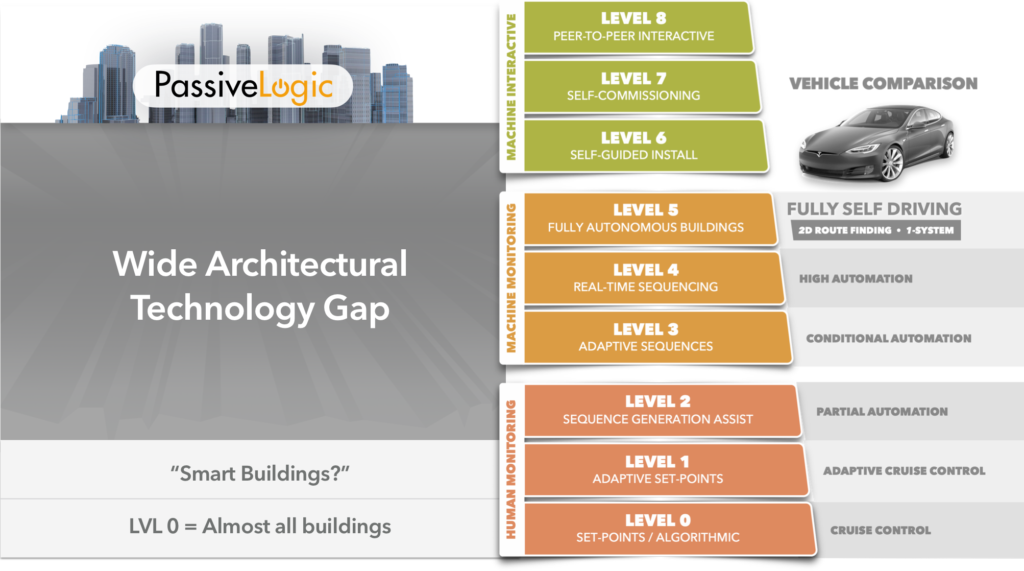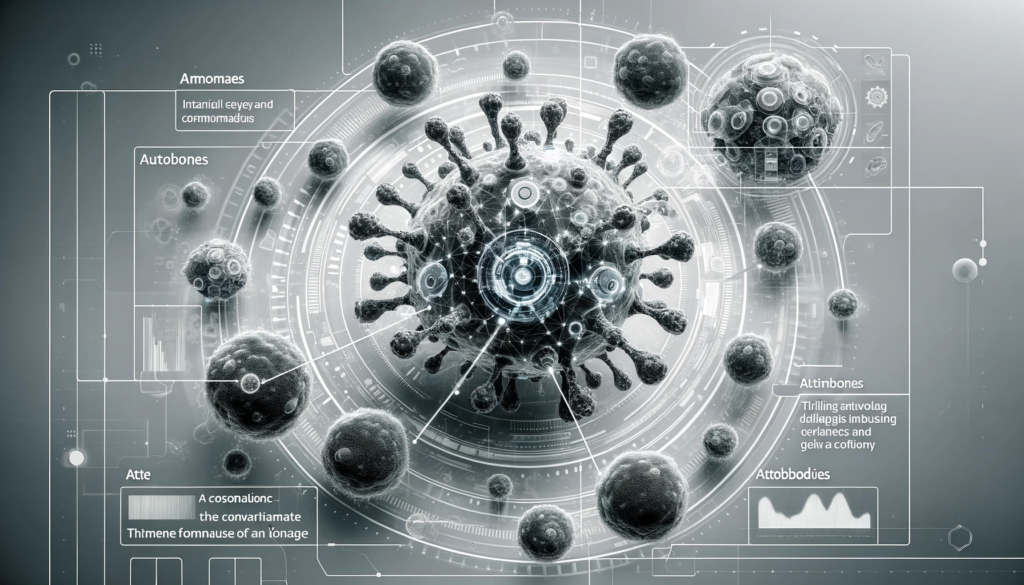I’m interested in the words we use as an industry. Words tell us a lot about our priorities, our attitudes. They’re descriptive and aspirational. Late last year, I got particularly interested in the word “autonomous” after I watched PassiveLogic’s Launch Event. Of course, I’d heard about autonomous vehicles, self-driving Teslas and what not, but never the idea of an “autonomous building”. What was this new word? How was an autonomous building different from an “automated” one? Was this a revolutionary idea or just marketing spin? I soon realized after some research, visiting PassiveLogic at AHR, and interviewing its CEO, that there’s a push to change the way we talk about building automation. In fact, there’s some real challenges with the words we currently use.
Who is talking about Autonomy?
So, what are popular terms within the building automation industry today? How are companies describing what they do? And what types of companies are using them? To get a rough snapshot, I did some quick and dirty keyword analysis of homepages for a dozen different automation companies, from the well-established Big Players to newer startups like PassiveLogic (omitted). I wanted to see what words companies were prioritizing in their online marketing. It wasn’t deep analysis, but it would get me some idea. I also wanted to see if the term “autonomy” appeared at all and, if so, which group was using it. Here were the top ten aggregated keywords I found for each group’s homepage or building automation page:
Big Players
- buildings
- control
- systems
- energy
- digital
- controls
- smart
- automation
- platform
- management
Mid-Level Players
- buildings
- controls
- smart
- systems
- management
- technology
- control
- automation
- software
- customers
Startups
- energy
- buildings
- carbon
- automation
- data
- emissions
- smart
- HVAC
- reduce
- decarbonization
Big Players
I found no instances of the word “autonomous” or its variations for these companies’ homepages or main BA pages. Unsurprisingly, the term “automation” did feature in the top ten keywords for each company and as a group.
Mid-Level Players—I only found one instance of “autonomous” among the four company homepages. Automation came in at the same level of usage as the Big Player group.
Startups—The phrase automation featured even higher in priority among Startups. Although the term “autonomous” wasn’t in the top 10, it did appear more often (3 times) than the other groups. Note: I omitted PassiveLogic’s page from the analysis because it was an outlier. Including its homepage keywords brought the word “autonomy” into the top ten.
The results suggest Big Players and Mid-Level companies have a broad marketing focus on technology, management, and customer engagement. They prioritize terms like “buildings,” “controls,” “smart,” “systems.” In contrast, “Startups” prioritize “energy,” “carbon,” and “decarbonization,” indicating a focus on energy efficiency, environmental impact, and innovative technology. The difference likely reflects Startups’ emphasis on niche markets or emerging trends like “autonomous buildings”, whereas larger players concentrate on established industry keywords.
None of these findings are surprising, but they do confirm that the word “automation” is firmly embedded in our industry lexicon, and that startups are the ones pushing the term into our marketing vocabulary. Most companies probably aren’t including “autonomous buildings” in their Google Ads bids. No one’s searching for it. However, a few are betting they soon will be.
The Need for New Terminology
To get an informed perspective on industry terminology, I spoke with Troy Harvey, an “autonomy” evangelizer himself and PassiveLogic CEO. Several years ago, Harvey penned a piece calling for a change in our terminology, arguing words like “automation” were a holdover from simpler technologies and that more recent terms like “smart” don’t accurately reflect what most buildings can do:
“The problem with today’s ‘smart buildings’ is they’re not actually smart. At best, they are merely ‘connected’…As our industry transitions to a diverse world of autonomous systems, AI, and distributed IoT — new terminology is required. As anyone operating in the space of ‘smarter’ systems can attest, the building automation industry’s lack of a clear lexicon is becoming a barrier to communication.”
Harvey hits upon an important point: our discourse needs to accurately describe our current and future states (i.e., where we are and where we’re going). Otherwise, confusion and inefficiency run amuck. Collective action is difficult. Customers can’t compare apples to apples. Companies can make wild claims. Everyone loses.
In short, the term/idea of “automation” is accurate with respect to current building technology, but it points to the past. And, while “smart” may be less technically precise, it somehow captures where we’re headed. So, what’s the answer?
For Harvey and company, the solution is to adopt the SAE’s Autonomous Vehicle Standards as a classification system for “autonomous” buildings. The SAE standards are an existing, familiar framework with a proven track record that breaks autonomous vehicle technology into five levels. Harvey regularly uses autonomous vehicles as an analogy for current and potential building technology—from basic cruise control to fully autonomous driving. Similarly, his autonomous building version moves from algorithmic set-points (Level 0) to fully autonomous buildings (Level 5).

The road to “autonomous” was a better way, he argues, not just because of its forward-looking connotations, but because autonomous vehicle standards were a well-established lexicon that would “provide clarity, chart a path to the future, and distinguish between technological architectures.”
“Using the model provides context,” Harvey states, “So we can point to things and say, ‘Oh, that’s a Level 0 autonomy solution,’ which is 99.99% of the stuff out there.”
When it came to the claim of marketing spin, the answer was clear: such an industry framework could help define what a technology actually does, not just what it claimed to do. Indeed, more precise language would help eliminate marketing fluff, not create it.
I would agree that as an industry we suffer from a paucity of words that’s left us a bit nearsighted. We lack a more nuanced way to describe, discuss, or market what we do. The claim that Inuit tribes have fifty words for “snow”, while wildly exaggerated, still shows that cultures within unique environments or entire industries themselves tend to have a more complex language about their specialized subjects. Sailors have numerous terms for wind and sea conditions, and sommeliers have a rich vocabulary for describing the nuances of wine. Harvey’s proposal to base building autonomy on an existing taxonomy adds much needed levels of clarity, complexity, and nuisance to a topic we too often over-generalized.
Automation & Autonomy: What’s the Difference?
Having human bodies, we all have an intuitive understanding of the difference between automated and autonomous systems. We contain both. For example, our knee-jerk reflex is an automated system. When the patellar tendon is tapped, sensory neurons transmit signals to the spinal cord, which tells our quadriceps muscle to contract. The “jerk” operates on a set path with a predetermined outcome. It’s like having a sensor and actuator directly connected through a simple control logic that triggers the same action every time a specific input is received, without the need for complex processing or decision-making. It is algorithmic and analogous to a basic chiller PID loop.
Our immune system serves as a prime example of autonomy. It can identify and remember pathogens and adapt its response accordingly. When a previously encountered pathogen invades the body, the immune system recognizes it and mounts a quicker and more targeted attack. Its ability to adapt its response illustrates the system’s decision-making capabilities. It learns from past encounters and adapts its strategy, showing a high degree of flexibility and self-governance.

While we might hope today’s “smartest” buildings approach the complexity of the immune system, the truth is the majority are much closer to the basic knee jerk. Or, to use the car analogy, the bulk of buildings today run on basic or adaptive cruise control.
In short, the fundamental difference between automation and autonomy lies in the ability to change and make decisions. Automation is static, autonomy is adaptive. We consider humans autonomous because we can adapt and change our environment. Without these qualities, we become mere robots programmed to do specific things, a collection of instincts and reflexes.
5 Levels of Autonomy for Buildings
Below is the full list of PassiveLogic’s proposed autonomous building levels with simple explanatory examples:
Level 0: Set-Points / Algorithmic
Example: Traditional thermostats in homes and offices where users manually set the desired temperature. The system maintains the set temperature using simple algorithms but requires manual adjustment for any changes in comfort or efficiency.
Level 1: Adaptive Set-Points
Example: Programmable thermostats that can adjust heating and cooling set points based on time of day or occupancy sensors. Users can program schedules, but the system cannot learn or adapt beyond these programmed settings.
Level 2: Sequence Generation Assist
Example: More advanced HVAC systems that can generate and suggest operational sequences to achieve better energy efficiency, such as suggesting the best times to increase or decrease temperature settings based on utility rates or expected weather conditions.
Level 3: Adaptive Sequences
Example: Smart HVAC systems that not only suggest but also adaptively implement sequences of operations based on real-time data, such as current occupancy patterns, weather forecasts, and historical energy usage data, to optimize comfort and energy use without human intervention.
Level 4: Real-Time Sequencing
Example: Building management systems that control various subsystems (like HVAC, lighting, and security) in real-time, adjusting operations instantly in response to changing conditions. These systems may use a network of sensors and real-time data analytics to dynamically optimize building performance continuously throughout the day.
Level 5: Fully Autonomous Buildings
Example: A building that operates entirely on its own without any human intervention, using AI to manage all systems. It predicts and adapts to the needs of occupants while optimizing for energy efficiency and maintenance. This might include adjusting environmental conditions in different parts of the building based on predicted usage patterns or even ordering its own repairs and maintenance services.
Conclusion
The discussion around “automation” versus “autonomy” isn’t just semantic nitpicking or marketing; it reflects a critical juncture in the industry’s evolution. The term “automation” has served us well, anchoring the industry in a period where programmed systems and passive technological functions were the pinnacles of innovation. However, as we stand on the cusp of a new era marked by artificial intelligence and machine learning, the vocabulary we employ must evolve accordingly.
PassiveLogic’s initiative to borrow the structured approach of Autonomous Vehicle Standards is not only a logical step but also an essential one. It marks a redefinition of what our buildings can achieve. It’s a vision that promises not just incremental improvements but a transformative leap. By adopting a clear, gradated taxonomy, we can better articulate the capabilities of building systems, set realistic expectations for consumers, and delineate a clearer path for the industry’s future development.
To learn more about PassiveLogic and autonomous buildings, visit their website.
References:
Harvey, Troy. Personal interview. 3 Jan. 2023
“Establishing a Smart Building Industry Standard.” AutomatedBuildings.com, Sep. 2019.


